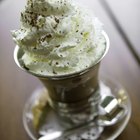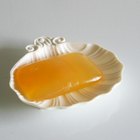
Whipped frosting tops your cake with a sweet taste and a beautifully airy texture, but that beauty fades quickly after you take your creation out of the fridge -- before long, you have runny frosting on your hands. To keep whipped frosting fluffy but firm, bakers turn to a technique known as stabilizing, or adding additional ingredients to the frosting that do not greatly affect its taste but enable it to hold its shape.
A Stable of Stabilizers
If you want to stabilize your whipped frosting, you have no shortage of options. Cornstarch and powdered sugar, or a mixture of the two, serve as common stabilizers for whipped frostings. For a completely tasteless stabilizer, turn to unflavored gelatin or piping gel. Meringue powder offers a slightly more durable stabilizer and a harder frosting, while cream cheese lends a subtly tart flavor and melted marshmallows give your frosting a sweeter, mellower taste.
How to Stabilize
While you should always follow the instructions of each particular recipe, many stabilizing processes share common steps. Typically, you add the stabilizers as you mix your frosting ingredients, first adding solid ingredients and then stirring in the liquids and heating the mixture, if the recipe calls for it. You generally only need a spoonful or two of stabilizing ingredients to make about a cup of whipped frosting. Start with a conservative amount of the stabilizer and sprinkle in more as you stir the frosting until your frosting takes on the desired thickness. With just the right amount of stabilizer, your whisk or beater will leave traces in the frosting and you'll be able to form small peaks that hold their shape.
Uses for Stabilized Frosting
Stabilized whipped frosting usually offers a subtly sweet flavor and a light, fluffy consistency that pairs well with a wide variety of cakes, from zesty lemon, cranberry and carrot cakes to delicate vanilla-flavored cakes or even rich, decadent chocolate cakes. This type of frosting almost always complements cupcakes -- the additional structure of the frosting helps keep fruits and ornamental toppings in place atop these small treats. Likewise, stabilized frosting makes it easier to decorate, texturize or shape the frosting on larger, more ornate cakes.
Stabilizers That Don't Affect Taste
If you use gelatin, you'll have to bloom the gelatin -- or sprinkle it in liquid and let it rest for a few minutes -- and dissolve it before adding it to your frosting as a stabilizer. If you do not want to use gelatin but you want a stabilizer that will not noticeably affect your frosting's taste, turn to agar agar. This Japanese thickening agent derives from algae, and does not contain any animal products.
Related Articles

How to Make Homemade Liquid Rouge

How to Make a White Decorator Icing

Sugar-Free Coconut Cream Pie

How to Add Irish Cream to Buttercream ...

Substitutes for Shortening in Frosting
What Do Bakeries Use in Their Whipped ...

How to Mix a Gelatin Glaze for Fruit

Adding Vanilla Pudding to Whipping Cream

What Is Certo Used For?

Recipe for How to Make Glycerin Soap ...

How to Make Almond Buttercream Frosting

How to Lighten Up Burgundy Frosting

Cupcake Decorating Ideas Without ...

How to Fix Grainy Whipped Ganache

The Difference Between Whipped Icing & ...
Best Homemade Cream Cheese Frosting

Do You Need to Refrigerate Whipped ...
How to Make White Drizzle Frosting

How to Heat Canned Icing

How to Moisten Hard Frosting
References
- Real Baking with Rose Levy Beranbaum: What Is the Best Way to Stabilize Whipped Cream for Frosting a Cake?
- Wilton: Stabilized Whipped Cream Icing
- Betty Crocker: Citrus Cake with Lemon Whipped Cream Frosting
- ABC: The Chew: Clinton Kelly's Classic Carrot Cake with Whipped Cream Cheese Frosting
- Good Housekeeping: Cranberry-Vanilla Cake with Whipped Cream Frosting
- Country Living: Gianna's Chocolate Whipped Cream Cake
Resources
Writer Bio
With a diverse professional background and a decade of experience as a freelance writer, Dan has contributed lifestyle content -- from fashion to travel to fitness and more -- to publishers including Chron, Fortune, Sony, GlobalPost, ModernMom, Moviefone, Salon.com, Techwalla and dozens of others.
Photo Credits
Jupiterimages/Photos.com/Getty Images